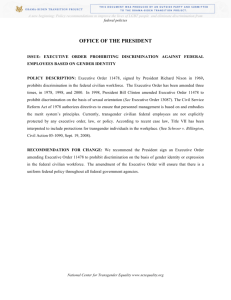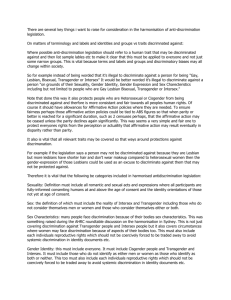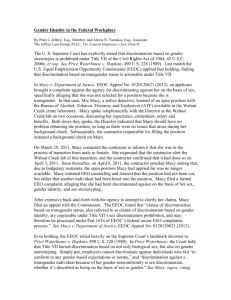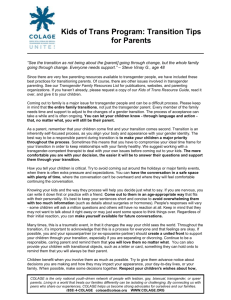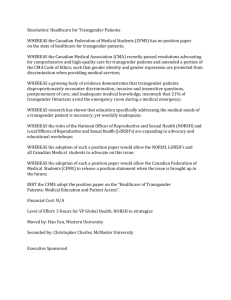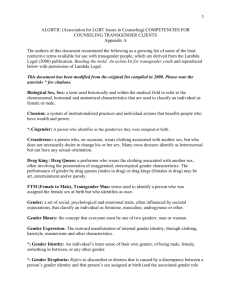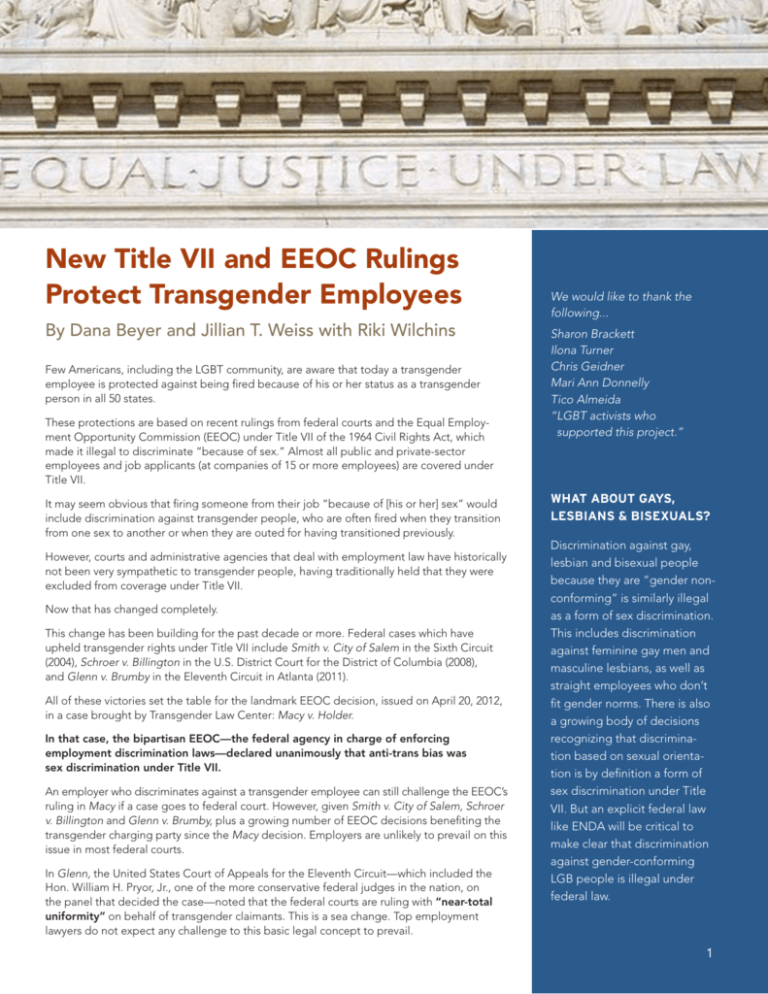
New Title VII and EEOC Rulings
Protect Transgender Employees
By Dana Beyer and Jillian T. Weiss with Riki Wilchins
Few Americans, including the LGBT community, are aware that today a transgender
employee is protected against being fired because of his or her status as a transgender
person in all 50 states.
These protections are based on recent rulings from federal courts and the Equal Employment Opportunity Commission (EEOC) under Title VII of the 1964 Civil Rights Act, which
made it illegal to discriminate “because of sex.” Almost all public and private-sector
employees and job applicants (at companies of 15 or more employees) are covered under
Title VII.
It may seem obvious that firing someone from their job “because of [his or her] sex” would
include discrimination against transgender people, who are often fired when they transition
from one sex to another or when they are outed for having transitioned previously.
However, courts and administrative agencies that deal with employment law have historically
not been very sympathetic to transgender people, having traditionally held that they were
excluded from coverage under Title VII.
Now that has changed completely.
This change has been building for the past decade or more. Federal cases which have
upheld transgender rights under Title VII include Smith v. City of Salem in the Sixth Circuit
(2004), Schroer v. Billington in the U.S. District Court for the District of Columbia (2008),
and Glenn v. Brumby in the Eleventh Circuit in Atlanta (2011).
All of these victories set the table for the landmark EEOC decision, issued on April 20, 2012,
in a case brought by Transgender Law Center: Macy v. Holder.
In that case, the bipartisan EEOC—the federal agency in charge of enforcing
employment discrimination laws—declared unanimously that anti-trans bias was
sex discrimination under Title VII.
An employer who discriminates against a transgender employee can still challenge the EEOC’s
ruling in Macy if a case goes to federal court. However, given Smith v. City of Salem, Schroer
v. Billington and Glenn v. Brumby, plus a growing number of EEOC decisions benefiting the
transgender charging party since the Macy decision. Employers are unlikely to prevail on this
issue in most federal courts.
In Glenn, the United States Court of Appeals for the Eleventh Circuit—which included the
Hon. William H. Pryor, Jr., one of the more conservative federal judges in the nation, on
the panel that decided the case—noted that the federal courts are ruling with “near-total
uniformity” on behalf of transgender claimants. This is a sea change. Top employment
lawyers do not expect any challenge to this basic legal concept to prevail.
We would like to thank the
following...
Sharon Brackett
Ilona Turner
Chris Geidner
Mari Ann Donnelly
Tico Almeida
“LGBT activists who
supported this project.”
WHAT ABOUT GAYS,
LESBIANS & BISEXUALS?
Discrimination against gay,
lesbian and bisexual people
because they are “gender nonconforming” is similarly illegal
as a form of sex discrimination.
This includes discrimination
against feminine gay men and
masculine lesbians, as well as
straight employees who don’t
fit gender norms. There is also
a growing body of decisions
recognizing that discrimination based on sexual orientation is by definition a form of
sex discrimination under Title
VII. But an explicit federal law
like ENDA will be critical to
make clear that discrimination
against gender-conforming
LGB people is illegal under
federal law.
1
WHAT ABOUT LOCAL LAWS?
There are also laws in 17 states,
the District of Columbia and
Puerto Rico, as well as in 140+
local jurisdictions, that explicitly
protect trans persons. These areas
combined cover nearly 50% of
the U.S. population. Given the
urban concentration of the out
trans community, it is fair to say
that a large majority of them
already have civil rights protections through state and local
ordinances, in addition to the
federal law, Title VII, that is the
subject of this paper.
DO WE STILL NEED ENDA?
Yes. ENDA—the Employment Non-Discrimination Act—is a federal bill
that would expressly make it illegal to fire someone because of their sexual
orientation or gender identity. As a law, it would add strength to the recent
rulings holding that Title VII protects transgender employees, it would educate employers and the community about those rights, and it would have
the added benefit of making crystal clear that gender-conforming gay,
lesbian and bisexual persons are also protected. Until ENDA passes, it is
technically possible—although extremely unlikely—that the U.S. Supreme
Court could reverse the very strong trend in the federal courts holding that
transgender employees are protected by Title VII.
It is uncertain how long it may take to pass ENDA. However, even without
ENDA, the EEOC ruling in Macy v. Holder and the strong trend in federal
court decisions make it very clear that transgender employees are covered
by existing law prohibiting sex discrimination.
Why Don’t More People Know About This Important Ruling?
The EEOC’s ruling in Macy v. Holder is not secret, and no one has tried to keep it secret.
However, it is fair to say most people in the transgender community, and even the wider
LGBT community, are unaware of it, and unaware of the very strong trend in court decisions holding that transgender people are protected from discrimination.
If you don’t know your rights, you can’t exercise them. Not many employers know about
these legal protections, either, which means they don’t realize that they can be held
liable for discriminating. And not many lawyers know about this ruling either, which can
make it difficult to obtain legal representation. Our goal in writing this document is to
IS IT A ‘SLAM DUNK?’
No. You still have to file your case
with the EEOC. If you receive a
cause determination from the
EEOC, your employer might then
work with you to resolve matters.
However, they can insist on going
to court. Because of the recent
strong trend in court and EEOC
decisions, you can expect to
prevail on the legal principle that
it’s illegal to discriminate against
someone for being transgender.
But you still have to prove that you
were in fact discriminated against,
and it’s YOUR responsibility to
collect and keep ALL possible evidence of what happened so you
can win in a hearing or lawsuit.
2
help you know your rights, so you can act.
So Our Problems Are Over?
No, not quite! Firings, lay-offs, failures-to-promote and failures-to-hire of transgender
employees will remain common. Laws only change so much, and in any case you still
have to bring—and win—a lawsuit.
However, few employers want to be on the wrong side of the law and expose
themselves to an embarrassing and costly federal lawsuit. Most of them are unaware
of the law.
So it’s YOUR job to be aware of the new ruling and your legal rights, and to use
them to protect yourself.
If you think you have a discrimination claim, call the EEOC: 1-800-669-4000.
For more details, check out Transgender Law Center’s step-by-step guide
to filing an EEOC charge at http://transgenderlawcenter.org/issues/
employment/eeoccomplaint.
For Lawyers
Title VII, 42 U.S.C. § 2000e-1, et seq., is the federal law that prohibits discrimination in
employment because of sex. In 1989, the United States Supreme Court ruled that sex discrimination includes discrimination based on “sex stereotyping,” or a person’s perceived
nonconformity with gender stereotypes. Price Waterhouse v. Hopkins, 490 U.S. 228 (1989).
Prior to the Supreme Court’s decision in Price Waterhouse, most courts to consider the
issue had ruled that transgender people were not protected by Title VII. Some of the most
prominent decisions ruling against transgender employees included Ulane v. Eastern
Airlines, Inc., 742 F.2d 1081 (7th Cir. 1984), Sommers v. Budget Marketing, Inc., 667 F.2d 748
(8th Cir. 1982), and Holloway v. Arthur Andersen & Co., 566 F.2d 659 (9th Cir. 1977).
The sex stereotyping theory established by Price Waterhouse started to turn things
around, however, as the logic of that decision clearly applied to employees who were fired
or denied a job for being transgender. Since Price Waterhouse, two of the thirteen federal
appeals courts have explicitly ruled that discrimination based on transgender status is a
prohibited form of sex discrimination under Title VII and/or the Equal Protection Clause:
the Sixth and the Eleventh Circuits, covering Alabama, Florida, Georgia, Kentucky, Michigan, Ohio, and Tennessee. The First, Ninth, and Tenth Circuits have also suggested that
such protections should now be available after Price Waterhouse.
Encouragingly, in the Glenn case
the Eleventh Circuit held: “[S]ince
the decision in Price Waterhouse,
federal courts have recognized
with near-total uniformity that
‘the approach in Holloway,
Sommers, and Ulane. . . has been
eviscerated’ by Price Waterhouse’s
holding that ‘Title VII’s reference
to “sex” encompasses both the
biological differences between
men and women, and gender
discrimination, that is, discrimination based on a failure to conform
to stereotypical gender norms.’”
Glenn v. Brumby, 663 F.3d 1312,
1318 n.5 (11th Cir. 2011)
Federal district courts throughout the country have also held that transgender plaintiffs can
pursue a sex stereotyping theory. In addition, the federal district court for the District of
Columbia has ruled that discrimination based on gender transition itself is per se sex
discrimination, and does not require further proof of stereotyping. Schroer v. Billington,
577 F. Supp. 2d 293 (D.D.C. 2008). More courts can be expected to follow this theory
in the future.
The EEOC’s ruling in Macy v. Holder, No. 0120120821 (EEOC April 20, 2012), is
based on this robust body of case law. As a practical matter, Macy means that if
a transgender person asserts that s/he was subjected to adverse actions based
on transgender status by a state or local government, or private-sector
employer with 15 or more employees, the EEOC must take the complaint and
investigate. If the EEOC finds that there is clear evidence to support the
complaint, it will issue a ruling in favor of the transgender employee, and
attempt to “conciliate” the complaint. If the employer rebuffs the EEOC,
the employee can bring the case to federal court under Title VII. The court
then hears the case de novo. EEOC rulings like Macy, while not strictly
binding on courts, are generally accorded some deference. Needless
to say, if a transgender discrimination case were brought in the
federal courts, all the rulings cited above would constitute, at a
minimum, extremely persuasive precedent in the plaintiff’s favor.
For discrimination claims brought by federal employees, the EEOC
can act as a judicial body and issue decisions itself. The Macy
decision is binding on all federal agencies.
For more details, see www.transgenderlawcenter.org/eeoc.
Nothing in this section or this paper should be construed as legal advice,
which can only be provided by a qualified attorney admitted in your jurisdiction.
3
More about State Laws
Seventeen states and D.C. have explicitly included gender identity as a protected
category: CA, CO, CT, DE, HI, IA, IL, MA, ME, MN, NJ, NM, NV, OR, RI, VT and WA.
A few other states have court rulings holding that other protected categories, such
as sex or disability, include transgender employees. Over 140 municipalities have
laws prohibiting discrimination based on gender identity. Examples of cities with
strong laws include New York City, San Francisco and D.C.
A BRIEF HISTORY OF TIME
The first state gender identity anti-discrimination law was passed in
Minnesota in 1993, nearly twenty years after the federal Employment
Non-Discrimination Act (ENDA) was first introduced by Congresswoman
Bella Abzug of New York in 1974.
Since that time, ENDA failed by one vote in the Senate in 1996, just ten days
after the passage of DOMA (the Defense of Marriage Act). In 2007, “gender
identity and expression” was excluded from ENDA before a House vote in
favor of a sexual orientation-only version.
During that debate it was argued that lesbian, gay, and bisexual people
needed those gender expression protections as well as trans people,
because much of homophobia is based on misogyny and rooted in rigid
codes of masculinity and femininity.
In 2013, a bill inclusive of both gender identity and sexual orientation passed
the Senate on a bipartisan vote in November 2013. Passage through the
Republican-led House would be the next challenge.
At the same time as the battle for ENDA was being fought on Capitol Hill,
lawyers, LGBT legal organizations, academics, and others were making
significant progress within the courts and federal and state agencies in
expanding the understanding of “sex discrimination” under existing laws
including Title VII of the 1964 Civil Rights Act.
FOR MORE INFORMATION
They began to build the arguments, and the case law, for protecting
transgender employees under Title VII. Because of their work, the federal
legal system has increasingly come to agree that workplace discrimination
against transgender persons is covered under Title VII. The successes of
these tireless advocates are the reason for this paper.
Transgender Law Center
transgenderlawcenter.org/help
415.865.0176 x306
Freedom to Work
freedomtowork.org
© Copyright 2014, Dana Beyer, Riki Wilchins and Jillian Weiss. All rights reserved.

